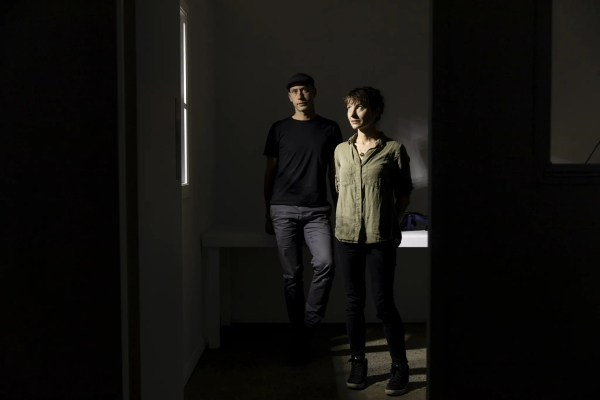[The installation described in this story from The Sydney Morning Herald uses virtual reality and presence to cultivate the awareness of future possibilities as a way to understand and prevent suicide. For more information about Edge Of The Present see The Big Anxiety website and listen to a 28:52 minute episode of the ABC radio program All in The Mind about empathy for mental health through the arts. For more on the research component of the project see the Workshop Participant Call Out page of The Big Anxiety site. –Matthew]

[Image: Future thinking: Michaela and Alex Davies in their installation Edge Of The Present. Credit: Dom Lorrimer]
Making the future a possibility
By Nick Galvin
October 8, 2019
Step through the door and you’re in a small, bare, unprepossessing room. The walls are white and the floor is concrete. There are two windows and a door. On a fixed table in the corner is a complicated-looking headset with built-in headphones.
Called Edge Of The Present, it’s an installation that combines art, research and mental health therapy in astonishing ways, with no clear boundary between any of these elements.
Edge Of The Present, which is part of Sydney’s Big Anxiety festival, comes from brother-and-sister team Alex and Michaela Davies. Alex is an award-winning media artist. Michaela is a musician and performance artist. Crucially, she is also a practising psychologist.
“I’m really interested in illusion and perception and making these mixed-reality environments where you have your reality, but there are these illusory aspects introduced into the space with media where you think things – virtual things or mediated experiences – are real,” says Alex.
Once you strap in and adjust the virtual reality headset, the room takes on an otherworldly, slightly off-kilter aspect that is still easily recognisable as the physical space you initially entered.
Start to explore the environment and extraordinary changes happen as it morphs into beautiful, natural scenes so real you feel you can touch, taste and smell what is around you.
Cleverly, physical aspects of the room such as the door handle and the window catch are mapped to the virtual reality headset, blending the physical with the virtual.
Of course, virtual reality (VR) is relatively common now, but Alex has a lot of reservations about how it is usually experienced.
“I really don’t like how it’s presented in museums and galleries where it’s very public,” he says.
“It goes counter to the actual mechanics of the experience and how you should experience it where you’re removing yourself from reality totally. Ideally, with VR you want to completely replace reality with the simulation.”
Following this thinking, Edge Of The Present, is an intimate experience lasting about 10 minutes for one person at a time.
If it were just a clever technological trick, Edge Of The Present would be impressive enough, but it has a much deeper purpose in examining the thought processes that can lead people to take their own lives.
A key aspect of so-called suicidal ideation is the patient’s inability even to allow for the idea there could be a positive future.
“This is trying to facilitate not the fact that the future will be great, but the possibility that there are different futures,” says Michaela.
As the visitor to the room explores the space more, so it blooms and changes, becoming more attractive, in a metaphor for the effect of positive future thinking.
“Even presenting the possibility that there might be something to live for is a good place to start [when counselling people] rather than suggesting the future is going to be amazing, because it might not be,” says Michaela. “It’s the possibility that if you’re open and you keep exploring, maybe there’s something more.”
Edge Of the Present has been developed in partnership with The Black Dog Institute and researchers there will use it to try to gauge the value of VR as a therapy for people with suicidal thoughts.
So is it art or a psychological experiment?
“I think of all art as a psychological experiment,” says Michaela.
Leave a Reply